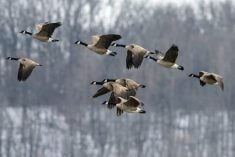Health Canada has reached the same conclusion as the U.S. Environmental Protection Agency: neonicotinoid seed treatments provide almost zero economic benefits for soybean growers.
In a draft report leaked to media and reported by Global News, Health Canada’s Pest Management Regulatory Agency said neonicotinoid seed treatments, sold by Bayer CropScience and Syngenta, offer a financial benefit of $9.7 million to Canada’s entire soybean sector.
The PMRA said the soybean industry has an annual farm gate value of $2.41 billion. An economic benefit of $9.7 million represents a gain of only 0.4 percent.
Read Also

Women who fed a nation
More than 40,000 young women supported the war effort between the 1940s and early 1950s, helping grow and harvest crops amid labour shortages. They were called Farmerettes.
Last fall, the U.S. EPA published a similar finding. It reported that neonicotinoid seed treatments added only $52 million to America’s soybean industry, an increase of 0.14 percent.
While it was skeptical of neonicotinoids for soybeans, the PMRA concluded that Canadian corn producers do benefit from seed treatments.
The report said neonicotinoids provide financial benefits of $81.6 million to Canada’s corn industry or 3.6 percent of the national farm gate value for corn in 2013.
Neonicotinoid seed treatments, commonly known as neonics, are applied to almost all of the corn and canola seeds in North America and a portion of soybean seeds.
The class of insecticides has been linked bee colony losses in North America and Europe.
PMRA experts have studied neonics intently since the spring of 2012, when the insecticides were blamed for widespread bee deaths in Ontario.
The EPA said there is no increase in soybean yields when neonic seed treatments are used compared to no pest control at all.
The PMRA wasn’t as harsh in its assessment.
Using data from the Ontario Ministry of Agriculture, Syngenta and Grain Farmers of Ontario, PMRA scientists said the yield benefit of three neonics — clothianidin, imidacloprid and thiamethoxam — ranges from two to 8.6 bushels per acre.
The PMRA said those yield benefits aren’t typical because the pests that cause soybean yield losses are uncommon.
“Individual soybean operations are likely to be impacted economically… when pests with no alternative pest management options (e.g., seedcorn maggot) are present in their fields,” the report said. “However, seed com maggot affects a small portion of the soybean crop compared to bean leaf beetle and soybean aphid… Growers do have access to alternative pest control products for control of bean leaf beetle and soybean aphids.”
The EPA said neonic seed treatments are ineffective against soybean aphids and the bean leaf beetle, the two major soybean pests.
“This is because the limited period of (neonic) bioactivity in soybeans (three to four weeks) does not usually align with periods of soybean aphid presence/activity,” the EPA report noted. “Similarly, neonicotinoid seed treatments are not effective in controlling bean leaf beetles as this pest occurs too late in the season.”
The PMRA’s argument was slightly different. It said neonics can be beneficial, but only when relevant pests are present.
“(Neonic) seed treatments complement current corn and soybean production practices such as the use of reduced tillage and no-till and the earlier planting of corn, while providing several pest management benefits for the control of soil insect pests,” the PMRA said. “However, the economic return from the use of neonicotinoid seed treatments is correlated to the prevalence of insect pest populations at levels that exceed economic thresholds.”
Robert.arnason@producer.com















